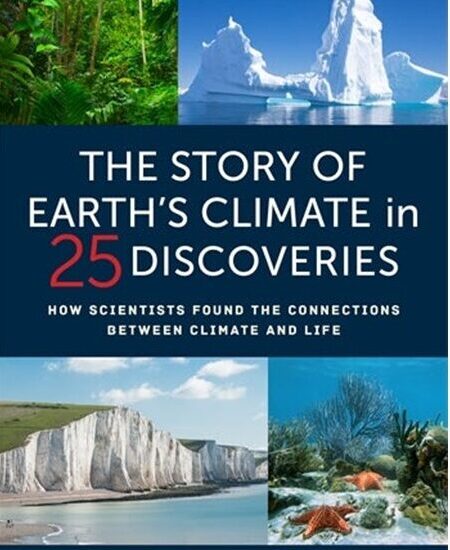The Story of Earth’s Climate in 25 Discoveries: How Scientists Found the Connections Between Climate and Life

From an iceless greenhouse to a glacier-carved ‘snowball’, the Earth has cycled through extremes that have repeatedly reshaped the planet and its inhabitants. Donald Prothero takes readers on a sweeping 4.5-billion-year journey that reveals the intimate ties between climate and life, and illustrates how geology, palaeontology, meteorology, and oceanography combine to illuminate the great ‘Earth system’.
Prothero also shows us not only what we know but how we know it, through a clear overview of the diverse scientific methods used to reconstruct the past. Fossils reveal lost biomes, sediment records capture cyclical patterns of tectonics and life, dropstones and erratics testify to long-vanished glaciers, and ice cores and tree rings preserve annual, even seasonal, snapshots of past climates. This evidence spans temporal and spatial scales; from chemical processes by microscopic organisms to planetary shifts, such as atmospheric oxygenation and the slow burial of carbon dioxide at ocean floors.
The Story of Earth’s Climate also highlights human tales, including palaeontologist Mary Dawson’s work revealing that the High Arctic once hosted tropical animals and evidences migration routes to support the theory of plate tectonics. Often the only woman in her classes or navigating field parties that excluded women, Dawson was a pioneer who went on to become Chair of Earth Sciences at the Carnegie Museum of Natural History, USA, and received the highest honours in palaeontology. Through such vignettes, Prothero highlights the cultural contexts of scientific paradigm shifts, and how discoveries often face long journeys through doubt and resistance before becoming accepted fact.
The role of serendipity in discovery is also celebrated, such as the notable example of the Messinian salinity crisis where construction of the Aswan Dam revealed immense buried canyons along the Nile, mirrored by similar findings on the Rhône, and confirmed that the Mediterranean Sea had once stood three kilometres lower.
Finally, Prothero traces how the climate has shaped human history: the early Holocene climate optimum enabled agriculture and early civilisation, the Medieval Warm Period aided Viking expansion, while the Little Ice Age may have inspired literary classics such as Frankenstein. The concluding chapter brings us to the present, warning of the scale and inevitability of the impacts of anthropogenic climate warming. By tracing how past climates have transformed, aided, and extinguished life, this book underscores the reality of today’s unprecedented rate of change.
Prothero’s writing treads a line between the autobiographical approach that much of modern popular science writing takes, and a purer focus on the concepts and chronicling of geological time. This results in a book with heft, but with the breadth and depth to resonate across the geoscience spectrum. The rich seam of scientific discovery throughout had me regaling friends with fascinating snippets long after I closed its pages.
Review by Dr Georgia Melodie Hole
DETAILS:
BY: Donald R. Prothero (2024) Columbia University Press, 480 pp. (pbk/hbk/ebook)
ISBN: 9780231222617
PRICE: £25 (pbk), £32 (hbk) cup.columbia.edu







